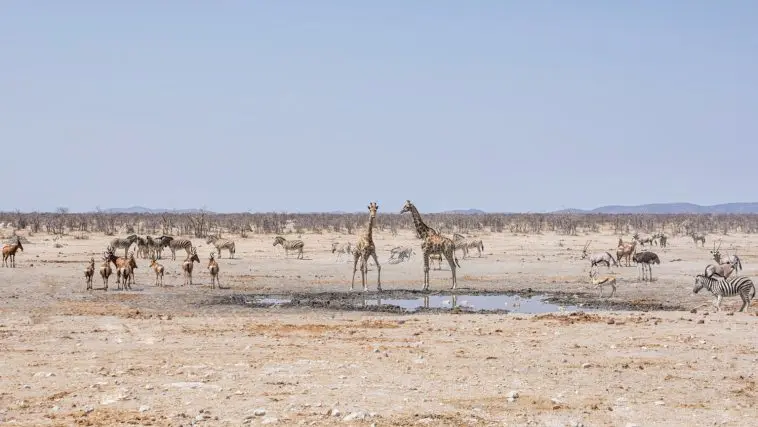[Originally published as part of What is Modeling Building? Continued from How to Build a Working Scientific Model of Creation]
We know that both the ideas of secular plate tectonics and of a universal common ancestor, in their current form, are wrong. This is because all models are wrong!
At the same time, the ability of these models to explain vast swaths of data demonstrates that they are useful to science. As such they are probably not completely wrong. Rather, both models have certain aspects that are likely correct and certain aspects that are likely incorrect. Acknowledging the strength of these models does not necessitate accepting that they are absolutely correct in their current form. It also does not mean that alternative scientific models cannot be considered, or that one of these alternatives may be able to explain the data even better.
The great thing about building creation models is that the work has already begun! Creation scientists have been at it for decades. Below, we will explore two examples and how they have been helpful in understanding scientific data, both in conventional and creation science.
A Model of Continental Plate Movement
Conventional Model: Plate Tectonics
The ability of plate tectonics to explain great swaths of data such as the distribution of fossils, the position of volcanoes, and the location and depth of earthquakes makes it a highly useful scientific model. We can even use lines of evidence, like the arrangement of certain mountain ranges, to estimate what pre-Pangaean supercontinents may have looked like. However, young-earth creationists have reason to suspect that the conventional plate tectonics theory is not entirely correct because the data is not always consistent with it.
For example, it extrapolates the modern rate of continental movement into the past. Continents are currently moving at about the speed your fingernails are growing (1.5 cm/year). At this rate, it would take hundreds of millions of years for the continents to arrive at their current configuration. This is much too long for a young-earth timescale of just thousands of years. Another problem is the discovery of cold, oceanic plates submerged deep within the earth’s hot mantle (7232°F).4 These plates should have melted by now if they had slowly sunk into the mantle over millions of years.
Creation Model: Catastrophic Plate Tectonics
In the 1990s, a group of creation scientists proposed a new model that could explain the same data already covered by conventional plate tectonics, and also much more. This model is called Catastrophic Plate Tectonics (CPT).5 While CPT operates by largely the same mechanisms as regular plate tectonics, it postulates that the global Flood of Noah’s day caused the division and rapid movement of the tectonic plates.
By quickening the speed at which continental plate movements occurred, the researchers behind CPT were also able to explain additional phenomena. For example, since the temperature and density of tectonic plates can increase or decrease the volume of ocean basins, CPT provides a major source of water for the Flood by forcing the seawater in the ocean basins onto the continents. It provides a mechanism for transporting and dumping thick packages of marine sediments onto the dry land. CPT also provides a mechanism for generating a brief Ice Age in the years following the Flood.
A few years later, one of the lead scientists of the Catastrophic Plate Tectonics project, Dr. John Baumgardner, demonstrated that such a phenomenon can be scientifically modeled, even when applying the laws of normal physics.1
What Does the Future Hold for Catastrophic Plate Tectonics?
Like any good scientific venture, CPT presents us with even more mysteries to solve. The processes that would have driven it should have also produced heat, and lots of it! Recent studies suggest that the heat produced by CPT would have been enough to boil all water in the oceans and melt the Earth’s crust 13 times over.2 Yet, seeing as life on planet earth was preserved through the Flood, death by excessive heat did not occur. This unresolved mystery has been called the heat problem.
Nonetheless, the presence of the heat dilemma does not negate the body of data supporting the concept of CPT. It is worth recalling that there was a time not too long ago when it was considered “physically impossible” for the continents to move at all. As briefly outlined earlier, there exists substantial evidence indicating that continents shifted, doing so at a pace significantly greater than their current drift rates. This, in turn, implies that the quandary stems from a gap in our comprehension of cooling mechanisms that restrained earth from attaining uninhabitable temperatures.
In the future, creation scientists endeavoring in this field will strive to identify and elucidate potential cooling mechanisms capable of mitigating the vast amount of heat generated during the Flood, reducing it to a negligible fraction.
A Model of Biodiversity
Conventional Model: Universal Common Ancestry
Now let’s look at model building in a different aspect of creation science. On the one hand, God created humans, as well as various plants, swimming animals, flying animals, and land animals, according to their kinds from the very beginning. They did not evolve from a common ancestor. Even today, we see a great variety of living things throughout the natural world that are very different from each other.
On the other hand, organisms do change over time, often to a great extent. Consider the diverse varieties of domestic dogs humankind has artificially bred from their ancestor, the wolf.3 Or consider observations of finch species populations on the Galapagos islands. Within as little as 40 years, we have witnessed significant changes to the size and shape of their beaks in response to shifting environmental conditions, and even the development of a new finch species.4 A good scientific model must be able to explain both of these trends.
Creation Model: The Refined Baramin Concept
To explain the trends described above, a group of young-earth biologists and paleontologists developed a model in 2003 called the Refined Baramin Concept.5 It builds upon the earlier work of biologist Frank Marsh which began in the 1930s.
The word “baramin” is roughly translated as “created kind” and is composed of two Hebrew words: bara (meaning “create”) and min (meaning “kind”). As such, a baramin refers to the lineage connecting the various life forms alive today and in the fossil record to their original ancestors God created in the beginning.
Upon their creation, God encoded each baramin with the ability to adapt to their environment and diversify. Ultimately, the Refined Baramin Concept is useful for creation research because it can explain why some organisms (within a baramin) are especially similar to each other. It can also explain why some organisms (of different baramins) are especially dissimilar from each other.
The reality that organisms change over time need not inherently support the idea of common ancestry of all life. Rather, the ability for life to diversify is indicative of a good Designer who created living things to fill the earth and its specific niches.
What Does the Future Hold for the Refined Baramin Concept?
The Refined Baramin Concept poses an intriguing question: How did so much transformation happen so swiftly?
To put it simply, many creatures we see today, like lions (Job 4:10–11; 10:16; 28:8; 38:39), domestic camels (Genesis 12:16), and donkeys (Genesis 12:16), were already around within the first few centuries or millennia following the Flood. This suggests that flying and land creatures must have undergone rapid diversification shortly after disembarking from the ark.
Young-earth biologists are actively studying this puzzle, and one idea put forward by Dr. Todd Wood involves mobile genetic elements.6 These are pieces of the genome that can independently replicate and move around in an organism’s DNA.
Mobile genetic elements can be envisioned as builders with a toolbox. They can flip switches on genes, make genes combine in new ways, and even shuffle complete genes from one place to another inside an organism. Today, we generally think of these mobile genetic elements as harmful parasites. However, it is possible that God originally designed them to cooperate with the genes of living organisms to generate diversity.
This capacity for genetic manipulation holds the potential to usher in significant transformations in an exceedingly short time span. But, of course, researchers are still exploring this fascinating area of study.
Are These Models the Final Answer?
Catastrophic Plate Tectonics and the Refined Baramin concept are powerful scientific models because they allow us to explain large swaths of data and make predictions about future findings. However, both models still have unresolved issues that will require more research to solve.
How were the incredible amounts of heat that Catastrophic Plate Tectonics would have produced alleviated from the earth’s system? How did so many species descend from just a few thousand created kinds within just a few thousand years?
These and other standing questions do not mean these models are failures. It means that while they have allowed us to make great progress, they are merely stepping stones on our stairway to truth. We as creation scientists march further into our quest for a better understanding of the Creator’s world.
The Future of Science is in Our Hands
Model building has proven time and time again to be an effective, forward-thinking way of moving creation research forward. While using data to demonstrate how aspects of the conventional model are incorrect can be a good thing, we should also use the data we gather to focus on the development of viable and comprehensive models.
Whether or not a future Copernicus or Newton comes along to replace evolution with something better depends on us. If creationists content themselves with critiquing evolution, nothing will change (or if it does change, it will not be favorable to creationists). If instead creationists apply themselves to the development of new theories of creation, who knows what might happen? ~Todd Wood
Footnotes
- Baumgardner, John R. (2003). “Catastrophic Plate Tectonics: The Physics Behind the Genesis Flood.” Proceedings of the International Conference on Creationism: Vol. 5, Article 13. ↩︎
- Worraker, W. (2018). “Heat Problems Associated with Genesis Flood Models—Part 1: Introduction and Thermal Boundary Conditions.” Answers Research Journal, 11, 171–191. ↩︎
- Drake, A.G, and Klingenburg, C.P. (2010). “Large-Scale Diversification of Skull Shape in Domestic Dogs: Disparity and Modularity.” The American Naturalist, vol. 175, no. 3. ↩︎
- Lamichhaney, S., Han, F., Webster, M.T., Andersson, L., Grant, B.R., and Grant P.R. (2018). “Rapid hybrid speciation in Darwin’s finches.” Science 359(6372):224–228. ↩︎
- Wood, T. C., Wise, K. P., Sanders, R., & Doran, N. (2003). “A refined baramin concept.” Occasional Papers of the BSG, 3, 1-14. ↩︎
- Wood, Todd Charles (2003). “Perspectives on Ageing: A Young-Earth Creation Diversification Model,” Proceedings of the International Conference on Creationism: Vol. 5, Article 36. ↩︎
- Wood, T. (2009). The Nature of Evidence [blog article]. Todd’s Blog. https://toddcwood.blogspot.com/2009/10/nature-of-evidence.html







